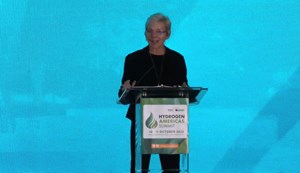News
Discussing the energy transition: The Hydrogen Americas Summit begins
Government representatives and energy stakeholders gathered in Washington, D.C., on October 10, 2022, for the Hydrogen Americas Summit, co-hosted by the Sustainable Energy Council and the U.S. Department of Energy (DOE). On day 1, Jennifer Granholm, Secretary of Energy for the U.S. DOE, delivered the opening keynote address to get the summit started.
Granholm began by conveying the importance of clean H2, claiming that it is “go time” for the U.S. “H2 is like the Swiss army knife for clean technologies,” Granholm said. “A tool that, if we get it right, can offer multiple benefits for economies and our efforts to overcome climate change.”
She went on to describe some of the things that the U.S. is doing to grow the clean energy market. Granholm mentioned the H2 Earth Shot, introduced last year, which aims to get clean H2 down to $1/kg within a decade, with an interim goal of $2/kg within the next four years. She mentioned the Bipartisan Infrastructure Law, which outlines the H2 strategy to get to net zero. The roadmap doubles previous goals from 5 MMtpy to 10 MMtpy of clean H2 by 2030 and contributes $9.5 B, of which $8 B is for clean H2 hubs and $1.5 B to help manufacture and lower the cost of electrolyzers.
Other programs include loan programs for major clean H2 projects in the U.S. and the Inflation Reduction Act, which offers a tax credit of up to $3/kg. Granholm then reveals that the winning teams of phase 1 of the H2 Earth Shot incubator prize will be announced the following day.
Granholm then pays respect to other countries and their strides toward a clean future. She mentions Chile’s goal of providing 70% clean power by 2030, Colombia’s new H2 roadmap and growing renewables sector and Canada’s three new H2 hubs. “The Department of Energy believes it is not about colors,” Granholm said. “It is about cutting carbon pollution, so if we want to grow this global clean H2 industry right, then we have to make it a clean H2 economy. In order to do that, we have to work together.”
Some other notable keynote presenters were Andrew Parsons, KC, Minister of Industry, Energy and Technology, Member for Burgeo−La Poile Newfoundland and Labrador and John Bel Edwards, Governor of Louisiana.
Parsons began by describing Labrador as the most Eastern part of North America, labeling it as home to an abundant number of natural resources. According to Parsons, this makes it a strategic location for hydro, wind, wave, solar and H2 development.
“You are not in this room if you don’t think there is a strong economic future for H2,” Parsons said. “You are not in this room unless you are ahead of the curve in adoption and want to stay ahead of that curve in adoption and commercialization. If you are thinking of using wind-based generation for H2 or ammonia export, our onshore capacity is greater than most offshore projects.”
In Edwards’ presentation, he began by describing Louisiana as the state to go to for developing H2. He said Louisiana recognizes the need to tackle the root causes of climate change and that they are the only state that over 50% of its CO2 emissions come from refining as opposed to power generation.
“As a state that’s well known for traditional energy production and consumption, we believe that Louisiana can be a great example of how we can transition and how that transition will work, providing the energy and jobs that our people need,” Edwards said.
Edwards went on to talk about the three-state partnership between Louisiana, Arkansas and Oklahoma, called HALO. The partnership aims to establish a multi-state hub for promoting the production and use of low-carbon H2. “The vision and development model for HALO was clear; to develop demand for low-carbon H2 and to demonstrate as many diverse end-use demonstration projects as can practically and reasonably show that the use of low-carbon H2 can be commercially viable, affordable in everyday situations and seamlessly integrate it into everyday applications,” Edwards said.
Story by: Tyler Campbell, Managing Editor, H2Tech


